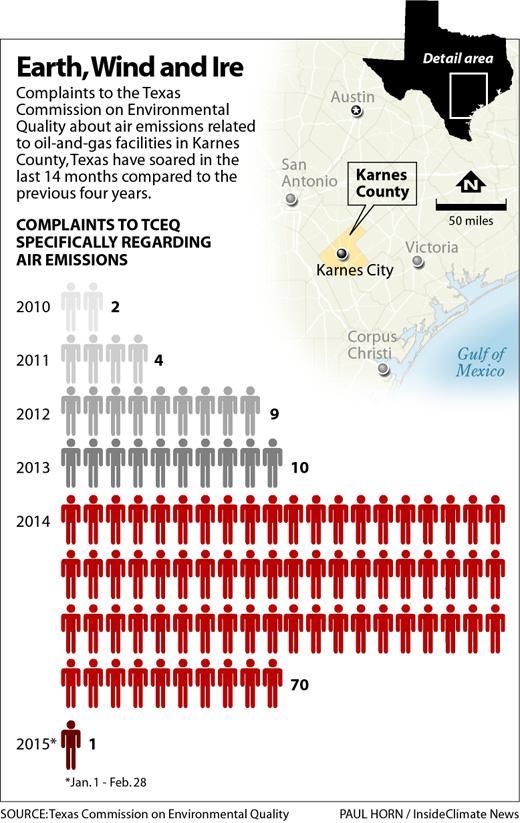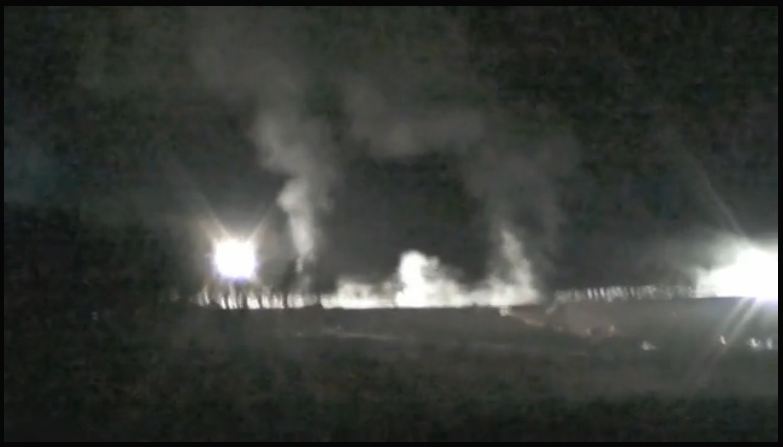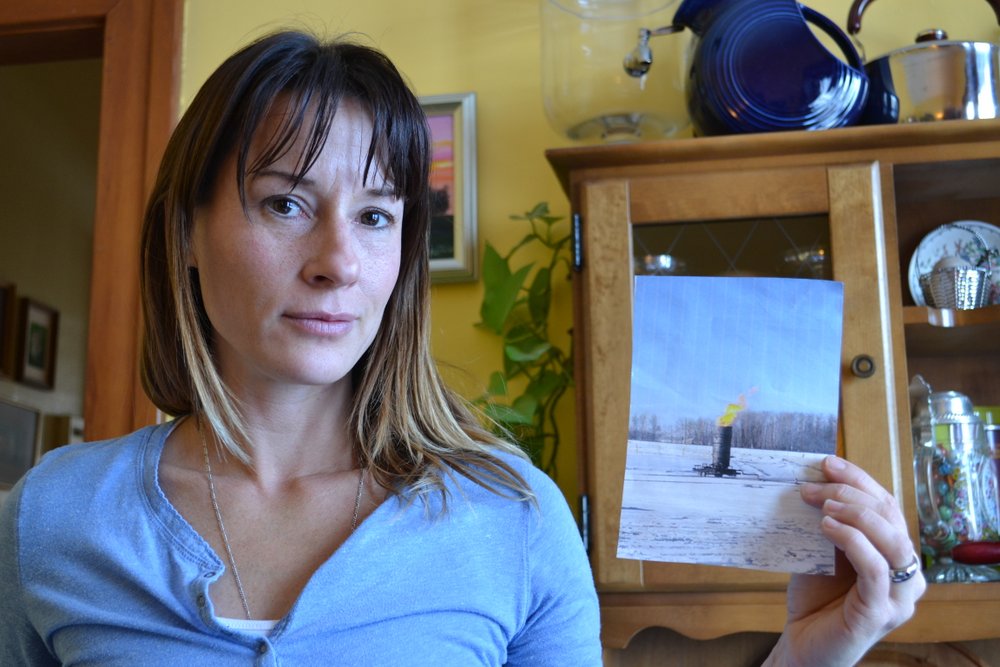Fracking Fumes Force Texas Resident to Shutter Home Business After a Decade, The Buehrings’ property on the south Texas prairie is surrounded by more than 50 wells and nine oil-and-gas facilities, all within 2.5 miles of their home by David Hasemyer, InsideClimate News March 22, 2015
It’s the height of tax season, when Texas tax preparer Lynn Buehring would usually be working horribly long hours to keep ahead of the crush of clients wanting to beat the April 15 filing deadline.
Not this year. After a more than a decade in business, Buehring has closed her Karnes County office.
Buehring said she was forced to shutter the business because noxious fumes from the dozens of oil-and-gas facilities that surround her rural home and office became so overpowering she could no longer work.
The unbearable odors also were driving away clients who couldn’t stand to come to her office, she said.
“The smell and how it would make you sick…I just couldn’t take it anymore,” Buehring said.
So she notified her 85 clients that she was closing the Business Barn––so named because Buehring had established her office in a small red barn that sat in the yard of the ranch house she shares with her husband, Shelby.
“It was the hardest thing to do,” she said. “But I had to do it.”
Buehring has been suffering from––and complaining about––the overpowering stench that has settled over their little white house ever since the oil-and-gas development hit Karnes County as part of the Eagle Ford fracking boom seven years ago.
Their property on the south Texas prairie is surrounded by more than 50 wells and nine oil-and-gas production facilities, all within 2.5 miles of their home of nearly 20 years. The foul air has caused Buehring blinding headaches, aggravated her asthma, burned her eyes and brought on nausea so bad that she’d have to lie down, she said.
Over the years, the Buehrings have filed nearly a half dozen complaints with the Texas Commission on Environmental Quality (TCEQ) and a civil lawsuit against two of the oil companies.The complaints have gone nowhere and the lawsuit is on hold pending the outcome of a similar case filed by neighbors.
Buehring fears there is no end in sight, either. She continues to complain, yet conditions only get worse, she said.
Since last year, another 1,200 wells have been permitted in Karnes County.
The TCEQ has received 71 complaints in the last 14 months from Karnes County about smoke, odors and emissions coming from oil-and-gas facilities. TCEQ recorded just 25 complaints between 2010 and 2013 from Karnes County.

Many of the facilities reported are the subject of repeated complaints.
Oil-and-gas-operators also have self-reported two dozen instances of unauthorized emissions in Karnes County involving flares that have malfunctioned and the release of toxic gas. (Flares are used to burn off natural gas that cannot be captured for later sale.)
An investigation last year by InsideClimate News, the Center for Public Integrity and The Weather Channel disclosed TCEQ’s air monitoring system is so flawed that the state knows almost nothing about the extent of the pollution in the Eagle Ford, which is one of the most active drilling areas in America.
Until earlier this year, there were only five permanent air monitors in the 20,000-square-mile Eagle Ford region, and all were located on the fringes of the shale play, far from the heavy drilling areas where emissions are highest. The locations were selected to measure pollutants migrating out of the drilling areas and into areas like San Antonio, where air quality has become a major concern.
But in the face of mounting pressure from local officials, news reports and the simmering discontent of residents, Texas regulators installed an air monitor in Karnes City, about five miles from the Buehrings’ house.
The monitor, which began operation in January, takes air samples once every hour for analysis of 46 volatile organic compounds, hydrogen sulfide, nitric oxide and nitrogen dioxide.
But that is little consolation to Buehring. After more than a decade of preparing taxes, she closed up shop because the foul air––which she has described as smelling like rancid chicken or baby poop––made it impossible to work.
Buehring said the stench was so powerful that she often had to wear a respirator and goggles in her little office where she’d sometimes work 18 hours a day, seven days a week during tax season. “That’s not how you want to go to work,” she said.
Clients complained, too.
“It got so bad that they’d call me and ask me to come to their place to pick up their records because they didn’t want to come to my office,” she said.
But most worrisome to Buehring was her concern that that her mental acuity was being affected the foul air.
“I thought, ‘I can’t afford to make a mistake on somebody’s taxes because I was not doing something right because of the air,'” she said.
Closing the business will mean a financial hit to the Buehrings, who relied on the $15,000 the Business Barn generated each year. Lynn Buehring, 59, counts on a small pension from her years as a school teacher while her 67-year-old husband draws Social Security and has a small retirement fund from his time as a welding supervisor. They get no income from the oil-and-gas operations surrounding their property.
“We’re going to have to tighten our belts,” she said.
The Business Barn sits nearly empty now. Buehring has sold the office equipment––file cabinets, desks and the copy machine.
She said she still get calls from clients asking her to do their taxes, but she declines.
“I was a tax preparer and now I’m a retired tax preparer; an involuntary retired tax preparer.” [Emphasis added]
[Refer also to the frac’d air in Alberta:
Photo by FrackingCanada: Night Frac in Alberta. Hold your breath all night long.
Calgary Herald reported that companies do not frac in the night. Why lie? Is the truth keeping CEO’s and the AER’s Bob Willard up at night?
Diana Daunheimer in her home near Didsbury, surrounded by Bellatrix (previously Angle)
Bob Willard, Senior advisor at the Alberta Energy Regulator, agreed to speak about current regulations.
David Kattenburg: Why aren’t these things being monitored for in the gases that are coming out from flaring and incineration stacks?
Bob: The long list that you’ve identified would be the responsibility for monitoring of not only the Alberta Energy Regulator, but the Environment department themselves, and I would direct you once again to ESRD for them to identify what their plans are relative to updating those guidelines.
David: I have actually, I’ve tried valiantly I’d say to try to get them to explain to me why they have these guidelines that say all industry MUST conform to these guidelines, and then I said well why does directive 60 of the Alberta Energy Regulator only establish monitoring requirements for sulfur dioxide and he said: “speak to the Alberta Energy Regulator.”
Bob: Um, it is important, and this is something the Energy Regulator does lead, is capturing the metrics of the volumes of material, so we do have good metrics as to the volumetrics.
David: But essentially nothing about the composition of those gases, other than sulfur dioxide.
Bob: A totally accurate composition, I would certainly volunteer that no, we do not have a totally accurate comprehensive information on the flare composition rather, we have it for the uh volumes, but not necessarily for the compositions.


